Respiration And Excretion Introduction
- Energy is needed by living as well as non-living things to do work. Without energy, they stop doing work. Our body needs energy to carry on its activities.
- Where do we get this energy? We have earlier studied that we all eat food. The food we eat is broken down into simpler forms during digestion. The digested food is then absorbed by the walls of the intestine and carried by blood to different parts of the body.
Read And Learn More: NEET Class7 Biology Notes
- How is the energy stored in the food (as chemical energy) used? This can be done by oxidation of the food materials.
- During oxidation, oxygen combines with the food we eat, liberating energy and carbon dioxide (a waste product).
This process of energy production takes place all through the day. Respiration can, thus, be represented as follows:
- Digested Food +Oxygen→Energy→Waste Products
- The released energy is stored in some special molecules.
Characteristics Of Respiration
Respiration is characterized by the following acts:
- Food is used up.
- Energy is produced.
- Exchange of gases occurs. Oxygen is used up and carbon dioxide is given out.
All the three acts take place in living cells.
- Respiration is a process common to all plants and animals. It is a process whereby living organisms produce energy from the food they eat. This energy is necessary for various life activities.
- Oxygen is required for this process and carbon dioxide is formed as a waste. How do we know that an organism respires? In respiration, oxygen is consumed and energy, carbon dioxide, and water are liberated.
- Therefore, if we can show that an organism consumes oxygen and gives off carbon dioxide and heat (any one parameter), we can say that it respires.
2. Types Of Respiration
Respiration is of two types based on whether oxygen is used up in this process or not.
Aerobic Respiration
- Most organisms require oxygen for respiration; such respiration is known as aerobic respiration.
- Food+Oxygen→Carbondioxide+Water+More energy
Anaerobic Respiration
- There are, however, some organisms like yeast and some bacteria which do not require oxygen. They can live without oxygen.
- The respiratory process in the absence of oxygen is called anaerobic respiration.
- Food→Ethyl Alcohol+Carbon dioxide+Less Energy

3. Process Of Respiration
The process of respiration consists of two main stages:
Breathing or external respiration: A physical process in which an organism takes in (inhales) oxygen and gives out (exhales) carbon dioxide.
This process involves the exchange of gases only. The exhaled air has more carbon dioxide than the inhaled air.
Cellular respiration or internal respiration: A chemical process in which food molecules are broken down into simpler molecules within cells and energy is produced. A number of chemical reactions catalyzed by enzymes occur during this process.
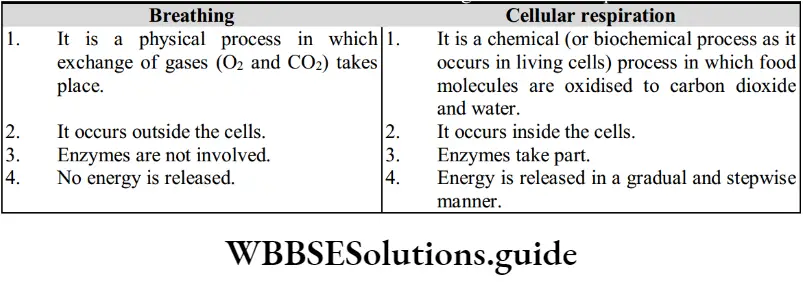
4. Combustion And Respiration
- Is the process of respiration similar to burning or combustion (of petrol or diesel in vehicle)? When we burn petrol or wood, oxygen is used up and carbon dioxide is given off.
- The energy is produced in the form of heat and light (flame). Something similar happens in our body. Yes, the two processes differ in many respects. The table given below lists the differences.
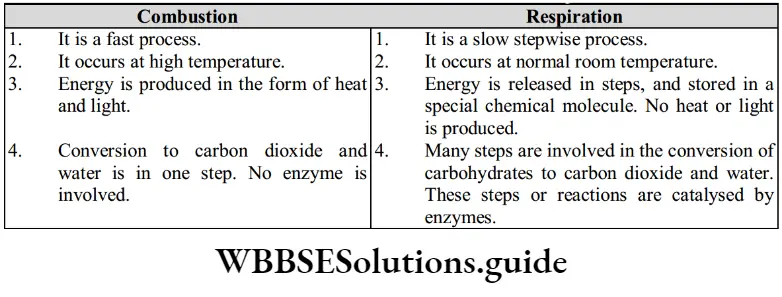
5. Respiration In Plants
The process of respiration is similar in all organisms, whether plants or animals – carbon dioxide is given out oxygen is used up, and a lot of energy is produced.
In plants, specific organs for breathing are absent. The exchange of gases, however, occurs by the process of diffusion. Diffusion of gases (oxygen and carbon dioxide) occurs through three sources.
- Through stomata (singular stoma), the minute openings on the surface of leaves.
- Through lenticels, openings present in old stems, and
- Through the general surface of the roots.
- In aquatic plants, gases diffuse through the body surface.
Stomata
- The opening is surrounded by two kidney-shaped cells called guard cells. The guard cells contain chloroplasts and carry out photosynthesis. Guard cells are surrounded by subsidiary cells.
- The whole structure consisting of the opening, guard cells, and subsidiary cells is called the stomatal apparatus. Cellular respiration in plants is similar to that found in animals. It occurs inside mitochondria.
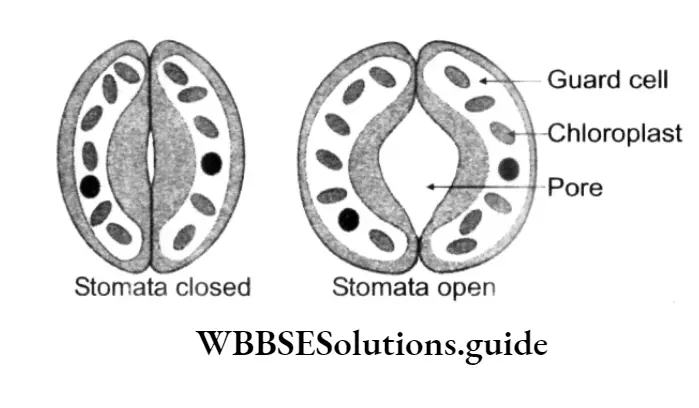
Anaerobic Respiration In Plants
- Respiration also takes place in the absence of oxygen. This type of respiration is called anaerobic respiration. This happens in the case of certain organisms like yeast and some bacteria.
- Even germinating seeds can respire in the absence of oxygen for some time. In this respiration, the food molecules (sugars) are incompletely broken into ethyl alcohol and carbon dioxide.
- The energy released is much less in comparison to that produced in the case of aerobic respiration.
6. Respiration In Animals
Exchange Of Gases – Breathing
- Different organisms have different methods of breathing:
- In Amoeba, for example, breathing occurs by simple diffusion. Hydra also breathes through the body’s surface.
- In insects, the movement of the skeleton draws air in and out of the openings called spiracles. These openings are present on the body surface.
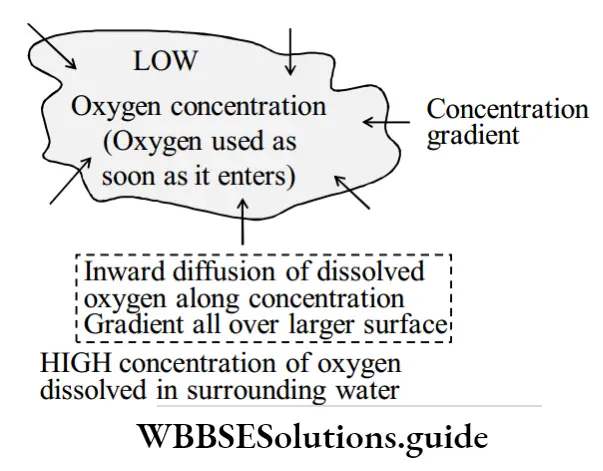
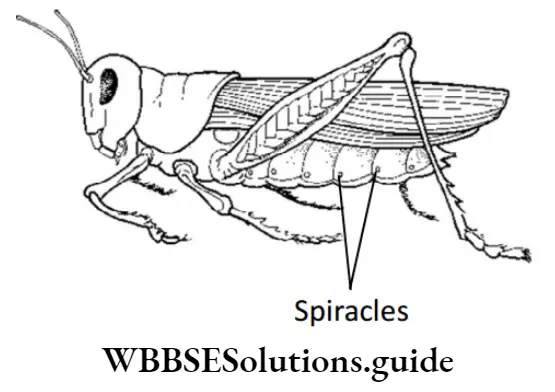
- Fishes and many other aquatic animals have special structures called gills. Through these gills, dissolved oxygen is used from the water entering these organs.
- Frogs when in water also breathe through their moist skin. Frogs, on land, breathe through their lungs.

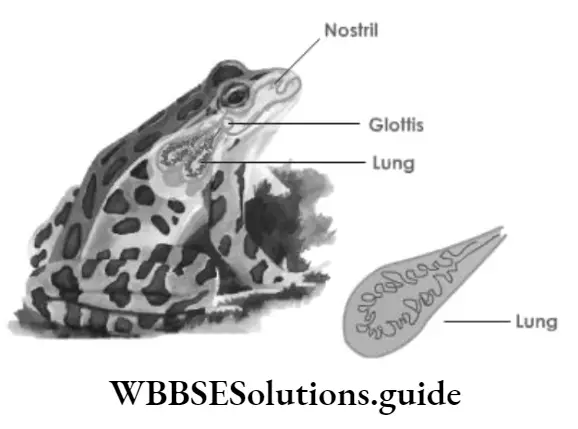
Earthworms absorb atmospheric oxygen through their moist skin.
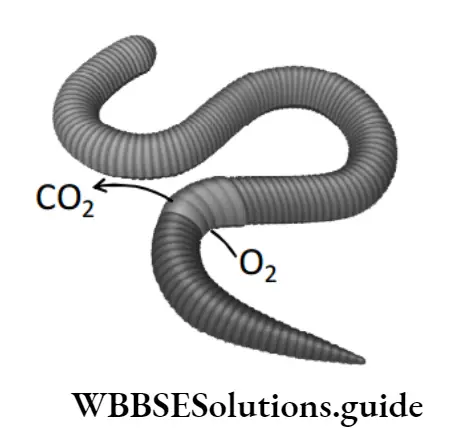
We breathe through our lungs. Movements of the ribs and diaphragm help to draw air in and out of our lungs through the nose.
7. Respiratory System In Humans
Respiratory System In Humans Consists Of Following Organs Meant For Breathing:
- Nose
- Trachea or windpipe
- Bronchi
- Lungs
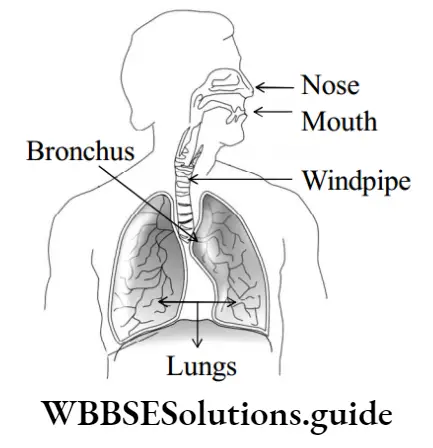
- When a person breathes in, air passes into the body through the respiratory tract starting with the nose.
- The hair inside the nose traps and stops the harmful particles from entering inside. The nose also warms the air.
- From the nose, the air goes down the windpipe or trachea. From here, the air goes through two smaller tubes called bronchi (singular bronchus), one of which enters each lung. The lungs are large, soft organs.
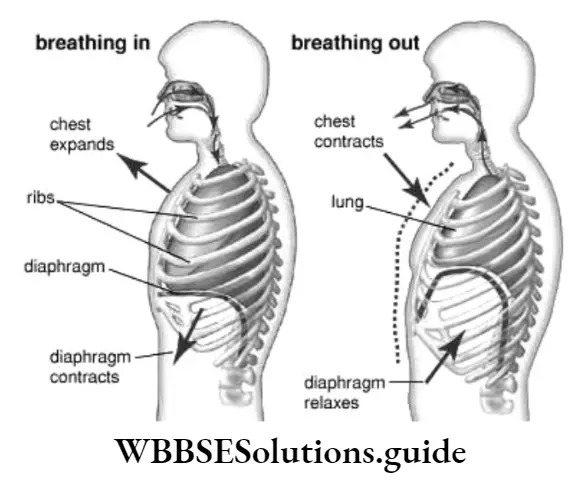
- In the lungs, each bronchus divides and redivides into finer tubes called the bronchioles. Windpipe each bronchiole ends in a number of air sacs, called alveoli (singular alveolus).
- Alveoli have very thin walls and are supplied with blood capillaries.
- It is here that air is received from the bronchi, the proper gases are used, and unwanted gases are forced out. Thus, the exchange of gases takes place in the alveoli.
- How the Diaphragm Helps In the Breathing Process Has Been Demonstrated In Activity Number 7.6.
- How does air move in and out of the lungs?
- Take in a deep breath. Now breathe out. Lungs are present in the chest cavity. The ribs surround this cavity on the sides. A large flat muscle called the diaphragm forms the floor of the chest cavity.
During inhalation (breathing in), two things happen –
- The ribs move out
- The diaphragm moves down.
This makes the chest cavity larger. The air then rushes into the lungs. The lungs inflate.
- During exhalation (breathing out)
- The ribs move downwards and inwards,
- The diaphragm moves up.
Thus, the chest cavity is reduced. Air rushes out of the lungs. The lungs become smaller.
Tidal volume is the volume of air that moves in or goes out in a single stroke and is about 500 ml.
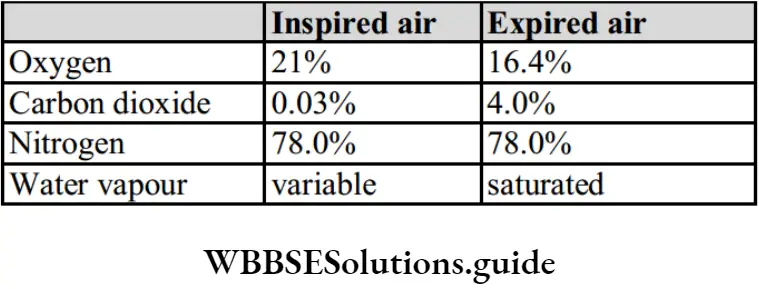
Role Of Blood In Respiration
- Blood is red because of the presence of a certain type of cells in it. These are the red blood cells.
- The red blood cells contain a pigment called hemoglobin. This pigment gives its red color to blood.
- Haemoglobin carries oxygen molecules as oxyhemoglobin. This substance acts as a respiratory carrier in the body. Oxygen diffuses to the cells as blood passes through tissues.
- At the same time, the blood collects carbon dioxide from the tissues and carries it to the lungs for breathing.
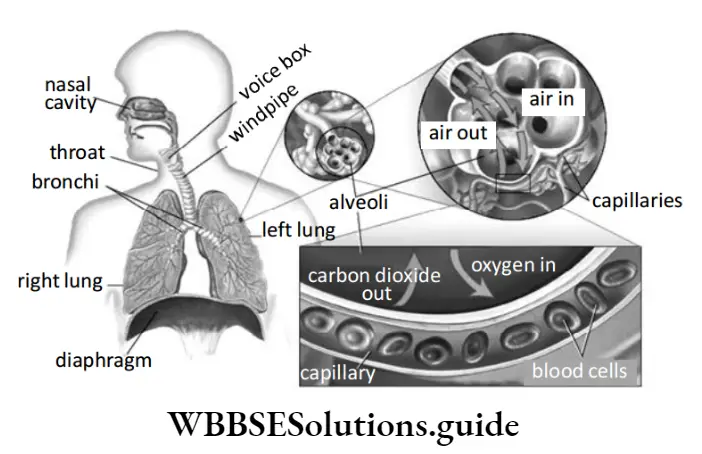
8. Transpiration
Transpiration is the process of loss of water in vapor form from the leaves in plants.
- It occurs through stomata present in the leaves by the process of diffusion. Water absorbed through the roots is moved upwards within the plant body.
- A part of it is used in the process of photosynthesis, and to stop the plant from wilting (drooping). The rest is lost as water vapor into the atmosphere from the leaves.
Factors Affecting Transpiration
- Day/Night: More transpiration takes place during the day than at night. This is because the stomata are open during the day and close at night.
- Wind: Wind increases the rate of transpiration.
- Humidity: The rate of transpiration is decreased if the air is humid. The air already contains a lot of water.
- Temperature: The rate of transpiration is higher on a hot day than on a cold day.
- Light: Light causes the stomata to open. This increases the rate of transpiration.
Importance Of Transpiration
- It results in the transport of water and minerals from the soil to the leaves. In the leaves, water forms the raw material for photosynthesis.
- It produces a cooling effect which helps in preventing hot sunlight from damaging delicate cells.
9. Excretion
- Living Organisms Perform A Number Of Activities. During These Activities, A Variety Of Waste Products Are Produced. For example, some of the food we eat is not used by our bodies.
- The undigested food is a waste product. During respiration, water, carbon dioxide, and heat are produced as wastes.
- Urea is another waste. It comes from used-up protein.
- Some of the waste products like urea are very harmful and toxic. These must not be accumulated within the body. Otherwise, the accumulation of waste produces health problems.
- Fortunately, each organism has a mechanism of its own to remove the waste products. The process of removal of the waste products is called excretion
Excretion In Lower Plants And Animals
In organisms like Amoeba, Paramecium. Hydra, most of the metabolic wastes are removed through the general surface of the body by the simple process of diffusion. Specialized organs of excretion are lacking.
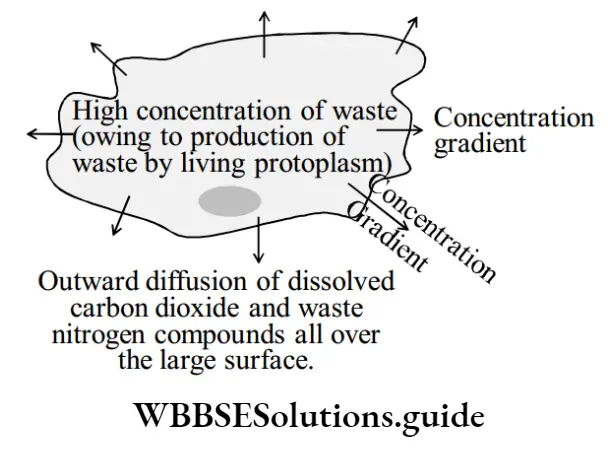
Excretion In Flowering Plants
Excretion of waste products is very simple and much less in plants as compared to animals. The waste products of one process are often used as raw materials in another process. This is very clear if you study photosynthesis and respiration.
Excess food material in many cases is stored in roots, stems, leaves, and seeds. These plant organs are often eaten by man. The various methods of excretion are given below:
- Waste products of photosynthesis and respiration – – oxygen, carbon dioxide, water, and heat – – are released into the atmosphere through stomata in the leaves and lenticels in stems. The waste products of one process are, however, usable as raw products in another process.
- Ammonia is formed as a breakdown product of proteins. Plants use this ammonia to synthesize useful compounds.
- Some of the waste products of photosynthesis are collected in the leaves and bark of trees. Plants shed their leaves and bark to get rid of these wastes.
- Some waste materials keep accumulating within cells. Calcium oxalate crystals, called raphides, are such wastes. Yam (zimikand) is rich in raphides.
- Several of the plant wastes are useful to us. Latex, gums, resins, tannins, sandalwood oil, and eucalyptus oil are such substances.
- Latex, a white milky fluid, oozes out from any cut on the stem is the case of some plants. Latex from rubber plants is used for making rubber. Resins are used for preparing varnish.
Excretion In Humans
The human body has various organs to get rid of waste.
- Lungs — for excretion of carbon dioxide and water vapor produced during respiration.
- Skin — For Excretion Of Urea, Salt, And Excess Water By Means Of Sweat Glands Present In The Skin.
- Large Intestine — for excretion of some wastes along with feces through the anus.
- Kidneys — for excretion of products like urea and nitrogen in urine.
- Liver — for removal of wastes from the blood.
10. Excretory System In Humans
The excretory system consists of the following organs:
- A pair of kidneys
- Ureters
- Urinary bladder
- Urethra.
Kidneys are bean-shaped structures, about 10 centimeters long.
- They are located just above the waist on either side of the backbone.
- Each kidney consists of a large number of coiled tubes called nephrons.
- Nephrons act as filters. They filter waste products from the blood.
- The waste materials collected in the kidney form the liquid urine. Urine contains 95 percent water, 2.5 percent urea, and 2.5% waste products.
- A narrow tube called the ureter runs from the inner side of each kidney.
- The ureters, in turn, are connected to a large sac called the urinary bladder.
- Urine passes from the kidney through two ureters into the urinary Nephrons bladder.
- Urine is collected and stored here. Nephrons, the coiled
- Leading from the bladder is another tube called the urethra. The urethra works as the outlet passage for urine.

